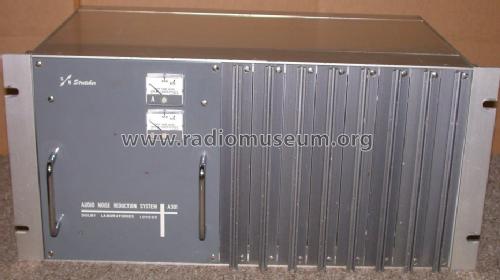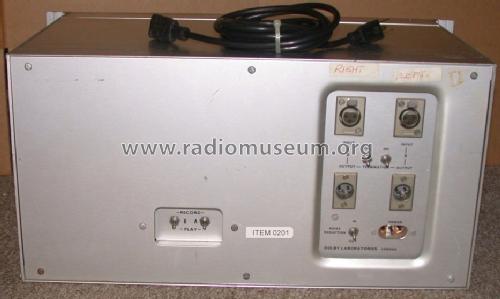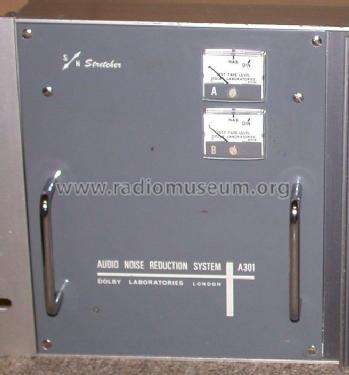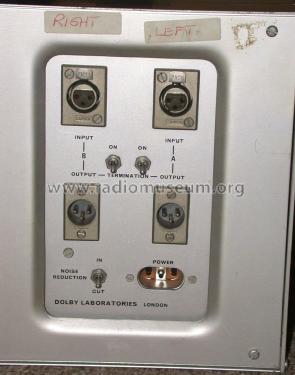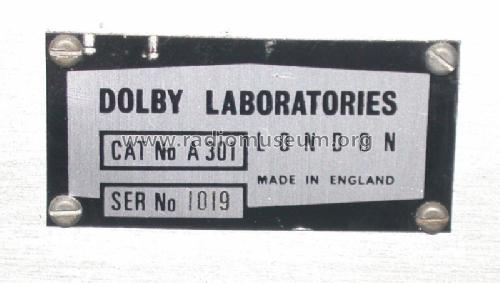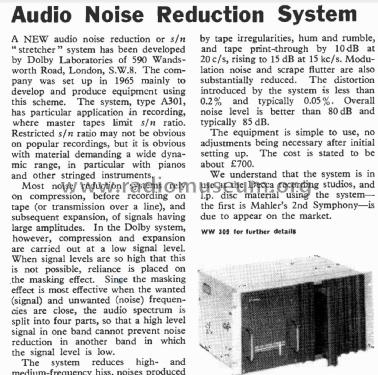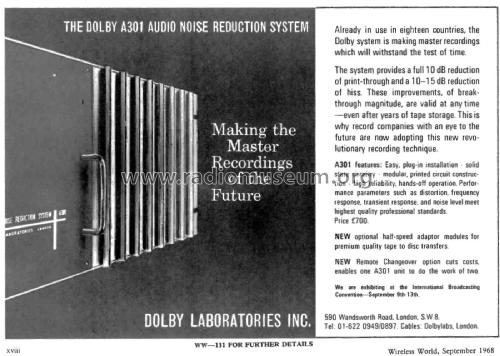Audio Noise Reduction System A301
Dolby Laboratories; London
- Country
- Great Britain (UK)
- Manufacturer / Brand
- Dolby Laboratories; London
- Year
- 1966 ?
- Category
- Miscellaneous (Other, Various) - see notes
- Radiomuseum.org ID
- 243990
- Number of Transistors
- Semiconductors present.
- Semiconductors
- Main principle
- Audio-Amplification
- Wave bands
- - without
- Power type and voltage
- Alternating Current supply (AC)
- Loudspeaker
- - For headphones or amp.
- Material
- Metal case
- from Radiomuseum.org
- Model: Audio Noise Reduction System A301 - Dolby Laboratories; London
- Shape
- Rack
- Dimensions (WHD)
- 19 x 0 x 0 inch / 483 x 0 x 0 mm
- Notes
-
2 channel Dolby type A Noise Reduction System for studio tape recorders.
A new audio noise reduction or s/n " stretcher " system has been developed by Dolby Laboratories. The company was set up in 1965 mainly to develop and produce equipment using this scheme.
The system, type A301, has a particular application in recording, where master tapes limit s/n ratio. Restricted s/n ratio may not be obvious on popular recordings, but it is obvious with material demanding a wide dynamic range, in particular with pianos and other stringed instruments. Most noise reduction systems rely on compression, before recording on tape (or transmission over a line), and subsequent expansion, of signals having large amplitudes. In the Dolby system, however, compression and expansion are carried out at a low signal level. When signal levels are so high that this is not possible, reliance is placed on the masking effect. Since the masking effect is most effective when the wanted (signal) and unwanted (noise) frequencies are close, the audio spectrum is split into four parts, so that a high-level signal in one band cannot prevent noise reduction in another band in which the signal level is low.The system reduces high and medium frequency hiss, noises produced by tape irregularities, hum, and rumble, and tape paint-through by 10 dB at 20 c /s, rising to 15 dB at 15 kc /s. Modulation noise and scrape flutter are also substantially reduced. The distortion introduced by the system is less than 0.2% and typically 0.05 %. Overall noise level is better than 80 dB and typically 85 dB.
The equipment is simple to use, with no adjustments being necessary after initial setting up.
The cost is stated to be about £700.
We understand that the system is in use at the Decca recording studios, and LP disc material using the system - the first is Mahler's 2nd Symphony is due to appear on the market.
- Price in first year of sale
- 700.00 GB £
- Mentioned in
- Wireless World (The), London (WW, 79) (Dec 1966, page 632.)
- Author
- Model page created by Gottfried Silberhorn. See "Data change" for further contributors.
- Other Models
-
Here you find 5 models, 5 with images and 0 with schematics for wireless sets etc. In French: TSF for Télégraphie sans fil.
All listed radios etc. from Dolby Laboratories; London
